Enhanced Salience and Emotion Recognition in Autism: A PET Study
Abstract
OBJECTIVE: This study examined neural activation of facial stimuli in autism when the salience of emotional cues was increased by prosodic information. METHOD: Regional cerebral blood flow (rCBF) was measured while eight high-functioning men with autism and eight men without autism performed an emotion-recognition task in which facial emotion stimuli were matched with prosodic voices and a baseline gender-recognition task. RESULTS: Emotion processing in autistic subjects, compared to that in comparison subjects, resulted in lower rCBF in the inferior frontal and fusiform areas and higher rCBF in the right anterior temporal pole, the anterior cingulate, and the thalamus. CONCLUSIONS: Even with the enhanced emotional salience of facial stimuli, adults with autism showed lower activity in the fusiform cortex and differed from the comparison subjects in activation of other brain regions. The authors suggested that the recognition of emotion by adults with autism is achieved through recruitment of brain regions concerned with allocation of attention, sensory gating, the referencing of perceptual knowledge, and categorization.



